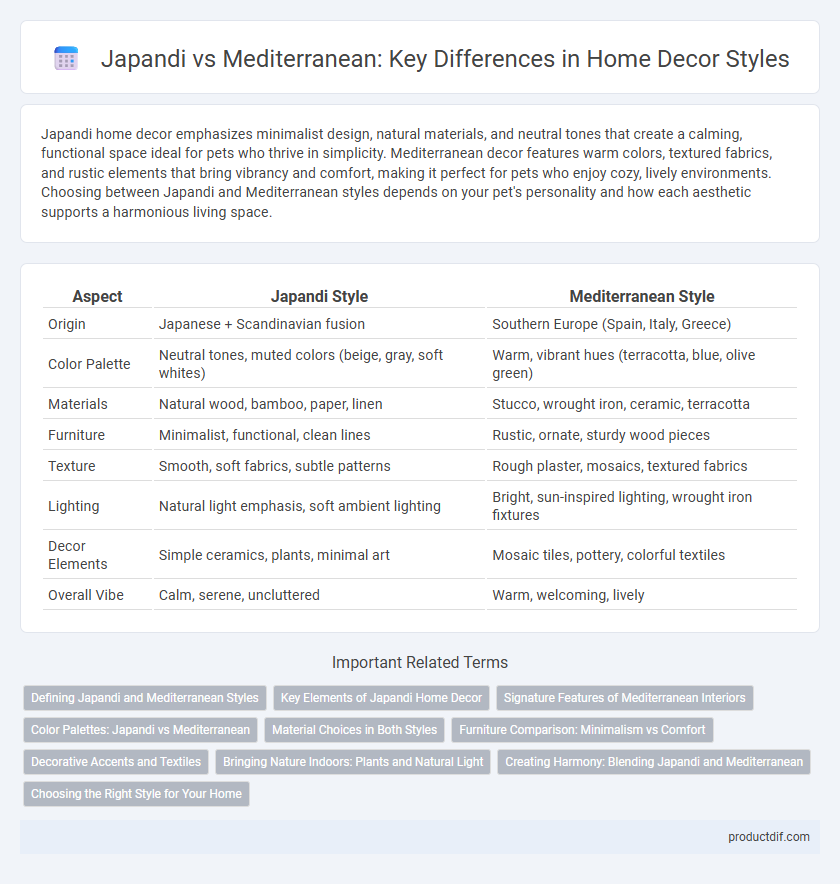Japandi home decor emphasizes minimalist design, natural materials, and neutral tones that create a calming, functional space ideal for pets who thrive in simplicity. Mediterranean decor features warm colors, textured fabrics, and rustic elements that bring vibrancy and comfort, making it perfect for pets who enjoy cozy, lively environments. Choosing between Japandi and Mediterranean styles depends on your pet's personality and how each aesthetic supports a harmonious living space.
Table of Comparison
| Aspect | Japandi Style | Mediterranean Style |
|---|---|---|
| Origin | Japanese + Scandinavian fusion | Southern Europe (Spain, Italy, Greece) |
| Color Palette | Neutral tones, muted colors (beige, gray, soft whites) | Warm, vibrant hues (terracotta, blue, olive green) |
| Materials | Natural wood, bamboo, paper, linen | Stucco, wrought iron, ceramic, terracotta |
| Furniture | Minimalist, functional, clean lines | Rustic, ornate, sturdy wood pieces |
| Texture | Smooth, soft fabrics, subtle patterns | Rough plaster, mosaics, textured fabrics |
| Lighting | Natural light emphasis, soft ambient lighting | Bright, sun-inspired lighting, wrought iron fixtures |
| Decor Elements | Simple ceramics, plants, minimal art | Mosaic tiles, pottery, colorful textiles |
| Overall Vibe | Calm, serene, uncluttered | Warm, welcoming, lively |
Defining Japandi and Mediterranean Styles
Japandi style combines the minimalist elegance of Japanese design with the warm, rustic elements of Scandinavian decor, emphasizing natural materials, muted color palettes, and functional simplicity. Mediterranean style draws inspiration from coastal regions of Southern Europe, featuring vibrant colors, textured walls, wrought iron details, and organic shapes that evoke a sunny, relaxed atmosphere. Both styles prioritize comfort and natural elements but differ in their cultural influences and color schemes.
Key Elements of Japandi Home Decor
Japandi home decor combines the minimalist aesthetics of Japanese design with the cozy warmth of Scandinavian style, emphasizing clean lines, natural materials, and neutral color palettes. Key elements include low-profile wooden furniture, handcrafted ceramics, and textiles made from organic fibers such as linen and wool. The use of clutter-free spaces, natural light, and subtle textures creates a serene and harmonious environment distinct from the vibrant patterns and rich colors typical of Mediterranean home decor.
Signature Features of Mediterranean Interiors
Mediterranean interiors showcase signature features such as warm, earthy color palettes inspired by terracotta, olive green, and ocean blues, creating a sun-kissed ambiance. Textured walls, wrought iron accents, and mosaic tile details highlight the artisanal craftsmanship prevalent in this style. Natural materials like stone, wood, and ceramics emphasize a connection to the outdoors, fostering a relaxed, inviting atmosphere.
Color Palettes: Japandi vs Mediterranean
Japandi color palettes emphasize muted tones such as soft beige, warm grays, and natural wood hues, creating a calm and minimalist atmosphere. Mediterranean color schemes prioritize vibrant shades like terracotta, deep blues, and sunlit yellows, evoking warmth and coastal charm. Both styles leverage natural elements but contrast sharply in intensity and mood through their distinctive use of color.
Material Choices in Both Styles
Japandi style emphasizes natural materials such as light woods like oak and bamboo, combined with organic textiles like linen and cotton to create a minimalist yet warm atmosphere. Mediterranean decor favors richer materials including terracotta tiles, wrought iron, and textured ceramics, alongside vibrant fabrics like linen and embroidered cotton to evoke a sun-soaked, rustic charm. Both styles prioritize authenticity and craftsmanship but differ in their tactile palettes--Japandi maintains simplicity and calming neutrals while Mediterranean embraces bold textures and earthy colors.
Furniture Comparison: Minimalism vs Comfort
Japandi furniture emphasizes minimalist design with clean lines, natural materials like wood and bamboo, and functional elegance that creates a serene, clutter-free environment. Mediterranean furniture prioritizes comfort through plush cushions, ornate wooden pieces, and vibrant colors that evoke warmth and casual luxury. Both styles balance aesthetics and functionality, but Japandi leans towards simplicity and calm, while Mediterranean embraces coziness and rich textures.
Decorative Accents and Textiles
Japandi style emphasizes minimalistic decorative accents with natural textures such as linen cushions and woven baskets, creating a serene and functional ambiance. Mediterranean decor showcases vibrant textiles featuring intricate patterns, rich colors like terracotta and cobalt, and handcrafted ceramics that add warmth and cultural depth. Incorporating organic materials in Japandi contrasts with the bold, artisanal elements typical of Mediterranean designs, highlighting their unique aesthetic identities.
Bringing Nature Indoors: Plants and Natural Light
Japandi style emphasizes minimalism with a focus on natural materials, incorporating indoor plants like bonsai and bamboo that complement its serene, neutral palette. Mediterranean decor brings vibrant elements through lush greenery such as olive trees and vibrant flowering plants, paired with abundant natural light streaming through large, airy windows. Both styles prioritize biophilic design by seamlessly blending indoor plants and sunlight to create calm, inviting living spaces.
Creating Harmony: Blending Japandi and Mediterranean
Blending Japandi and Mediterranean styles creates a harmonious home decor by combining Japandi's minimalist, natural elements with the Mediterranean's warm, vibrant colors and textures. Emphasizing clean lines, neutral palettes, and handcrafted ceramics from Japandi complements the Mediterranean use of terracotta, rustic wood, and lively textiles, fostering a balanced, inviting atmosphere. This fusion results in a serene yet dynamic space that celebrates simplicity and cultural richness while promoting comfort and elegance.
Choosing the Right Style for Your Home
Japandi style blends Japanese minimalism with Scandinavian functionality, emphasizing natural materials and neutral tones for a tranquil, clutter-free environment. Mediterranean decor incorporates vibrant colors, ornate patterns, and rustic textures inspired by coastal regions, creating a warm and inviting atmosphere. Select Japandi for a sleek, serene aesthetic or Mediterranean for a lively, cozy ambiance tailored to your personal taste and living space.
Japandi vs Mediterranean Infographic

 productdif.com
productdif.com